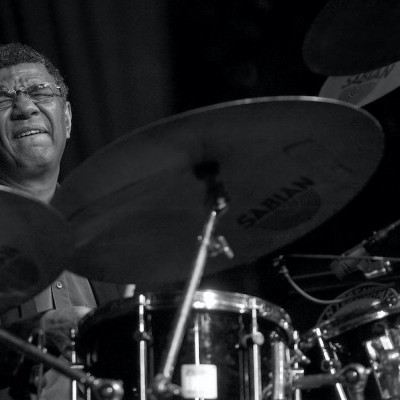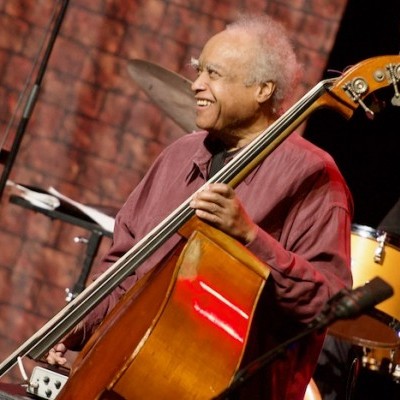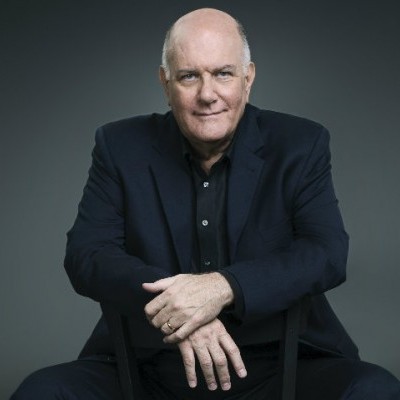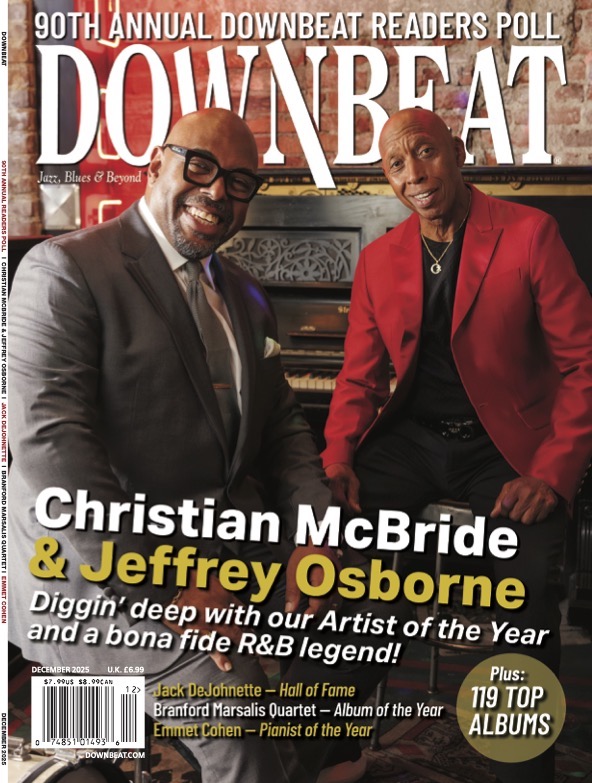Oct 28, 2025 10:47 AM
In Memoriam: Jack DeJohnette, 1942–2025
Jack DeJohnette, a bold and resourceful drummer and NEA Jazz Master who forged a unique vocabulary on the kit over his…

“I’m not sure if everybody wants just angry music,” says Tobia Meinhart. “Maybe we need something more hopeful and inspiring instead.”
(Photo: Mariana Meraz)Tobias Meinhart moved from Germany to Brooklyn, New York, 15 years ago to follow his dreams of being a jazz musician. And while he’s established his reputation as a commanding tenor saxophonist and gifted composer both in the Big Apple and in various European and South American countries, it wasn’t until this year that he explored parts of the Midwest with a few dates on the West Coast.
With funding from South Arts’ Jazz Road Tours, a $15,000 grant, Meinhart and his quartet — consisting of pianist Julian Shore, bassist Matt Penman and drummer JK Kim — began the auspicious adventure in early March in Minneapolis. From there, they visited Spring Green and Madison, Wisconsin; then Sioux Falls, South Dakota. They also performed in Los Angeles then Portland, Oregon — the latter date feature Mark Whitfield Jr. replacing Kim — before concluding the month-long excursion in New York at the Django.
Exploring Middle America
While driving through the Midwest, Meinhart recalls seeing very few vehicles on the roads. Yet the U.S. landscape captivated him. “It’s just all so beautiful,” he said in early April, right before he left New York once again, this time for a 14-date European tour with his Berlin People combo.
“[The tour] gave me a really different perspective of the country after being so much in New York City, where everything is dense and loud.” In addition to geographical beauty, Meinhart was taken by the warm reception he and his ensemble received. When they played in Spring Green, Wisconsin, he recalled one resident who had immigrated from Poland 30 years ago. “He started crying after hearing us,” Meinhart says. “He said that the music had touched him so much.”
Meinhart says that the Spring Green resident was so moved that he took a four-hour drive with his family to catch the next show in Sioux Falls, South Dakota. “That never happens in New York,” Meinhart said. “The art is so abundant in New York that hardly anyone cares. For many people in New York, art is just there. But to see that type of gratitude, it reminded me that this music is not all for nothing. That gratitude keeps me going. That and interacting with people.”
Living in America
Meinhart possesses a burnished, velvety tone on the tenor with which he animates with supple improvisational lines that are often melodically mindful but can coil and unravel in cursive, calligraphy-like designs with both poise and passion. In conversation, he’s as amicably engaging as his saxophone playing. He answers questions with considerable thoughtfulness without being haughty. And he’s prone to query other people regarding their thoughts and life experiences with genuine concern.
He said that his tour to the Midwest was a step further in understanding the United States. He argues that he felt challenged in certain ways about some of his preconceived notions of middle America. Right now, many people are trying to understand the U.S. within the context of its current sociopolitical climate as the Trump administration has aggressively attacked immigrants, Black people, the LGBTQ community, the federal government, higher education institutions and the legal profession — all of which appears as if he’s guided by the Heritage Foundation’s notorious “Project 2025” playbook.
Project 2025’s tentacles have already infiltrated some of the U.S.’s most heralded art institutions, specifically the Kennedy Center, Voice of America and the Smithsonian with antagonistic measures designed to both quell dissenting voices and erase cultural, historical footprints made by marginalized communities.
In light of that, Meinhart reflects on what inspired him to move to the U.S. “It was really for me to be myself,” he says. “I could be a jazz musician; I could be an artist. Whereas in the small village outside of Regensburg, Germany, in the Bavaria region, I suffered a bit because being an artist is looked as something being exotic. You could do music on the side, but people would ask, ‘So, what’s your real job?’”
He loves living in Brooklyn because it gives him a chance “to just be.” “But now, I feel like that idea is being challenged,” Meinhart said. “I worry about that. I hope we find a way to preserve that freedom ‘to just be’ for everyone. But I’m very optimistic. As musicians, we have this gift of having strong communities.”
Nevertheless, with an uncertain backdrop in the U.S., Meinhart believes that a lot of beautiful art can be created in resistance. “We have to come together and make it through these challenging times,” he said. “So, what are we going to do? What kind of art are we going to make? I’ve been thinking about this a lot. Does that mean now that all the music we create must be angry? It’s OK to put out angry music if that is what you’re feeling. But what do the people really need at this moment?
“Contrary to what some people believe, it might be something joyful or pensive,” he continues. “As I get older, I’m not sure if everybody wants just angry music. Maybe we need something more hopeful and inspiring instead of something just angry.”
Meinhart’s Water Offering
To that end, Meinhart’s newest self-released album, Sonic River, delivers a balm in these trying times. The album features him fronting one of his New York-based ensembles that includes drummer Obed Calvaire, bassist Matt Penman, guitarist Charles Altura and pianist and pump organist Eden Ladin.
Throughout Sonic River, Meinhart weaves multiple themes that touch upon his love for the outdoors. The album’s watery title alludes to both the Danube River, Europe’s second largest river, which flows near his hometown; and New York City’s East River, which he passes routinely. He also underpins the album with his love for literature. Compositions such as the alluring “This Is Water,” the enchanting ballad “The Panther” (featuring singer Sara Serpa) and the suspenseful “Mr. Vertigo” reflects his respective readings of David Foster Wallace, Maria Rilke and Paul Auster.
“I’ve loved reading ever since I was kid,” Meinhart said. “Growing up, I would be under the blankets — before smartphones — with a book and lamp, because my parents would turn off the lights and say, ‘Time to sleep.’”
Augmenting his love of literature is the inspiration Meinhart draws from his wife, award-winning photographer and filmmaker Mariana Meraz. “She comes from a very artistic family,” he says. “Her parents are writers. I’ve always loved reading. But she’s opened me up to a lot of things that I didn’t know before. She’s opened me up to a lot of other music and paintings, too. I also learned how to speak Spanish from her. We met through our love for books.”
Returning to the aquatic flowing analogy, it also speaks to Meinhart’s artistic goal as to how he approaches improvisation and honing his voice. “To me, it’s all about having this flowing feeling and being so immersed in something that you love,” he says. “It’s not being so self-absorbed in your thoughts; it’s riding that perfect wave, when everything feels good and you don’t have to force the creativity.”
As 43-year-old Meinhart continues evolving, he said that he hopes to lose more of the feeling of self. “I want to be all giving in my music and make everyone sound good,” he explained. “It’s about being braver on the bandstand. My favorite musicians are the ones that allow themselves to be vulnerable. I want to evolve into the most open version of myself, both on and off the bandstand with little preconceived notions and judgements.” DB

Jack DeJohnette boasted a musical resume that was as long as it was fearsome.
Oct 28, 2025 10:47 AM
Jack DeJohnette, a bold and resourceful drummer and NEA Jazz Master who forged a unique vocabulary on the kit over his…

D’Angelo achieved commercial and critical success experimenting with a fusion of jazz, funk, soul, R&B and hip-hop.
Oct 14, 2025 1:47 PM
D’Angelo, a Grammy-winning R&B and neo-soul singer, guitarist and pianist who exerted a profound influence on 21st…

To see the complete list of nominations for the 2026 Grammy Awards, go to grammy.com.
Nov 11, 2025 12:35 PM
The nominations for the 2026 Grammy Awards are in, with plenty to smile about for the worlds of jazz, blues and beyond.…

Drummond was cherished by generations of mainstream jazz listeners and bandleaders for his authoritative tonal presence, a defining quality of his style most apparent when he played his instrument unamplified.
Nov 4, 2025 11:39 AM
Ray Drummond, a first-call bassist who appeared on hundreds of albums as a sideman for some of the top names in jazz…

Jim McNeely’s singular body of work had a profound and lasting influence on many of today’s top jazz composers in the U.S. and in Europe.
Oct 7, 2025 3:40 PM
Pianist Jim McNeely, one of the most distinguished large ensemble jazz composers of his generation, died Sept. 26 at…





